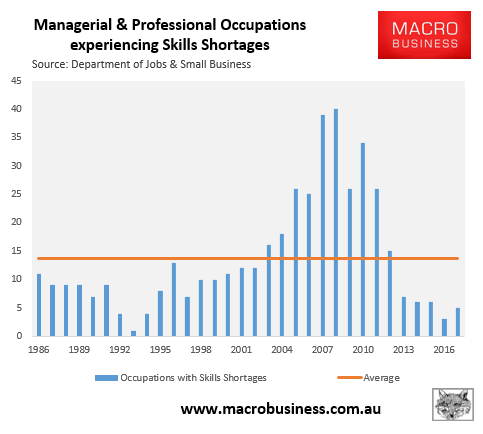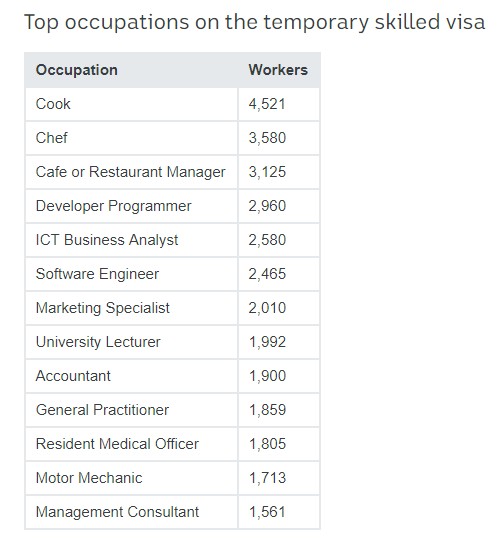MB has long argued that Australia’s skilled visa program is poorly targeted with the majority of visas granted to professions experiencing an oversupply of workers.
The below chart illustrates the problem. According to the Department of Jobs and Small Business, skills shortages across managerial and professional occupations were running way below the historical average at near recessionary levels in 2017 (latest data available):

This matters because out the 111,099 skilled permanent visas handed out in 2017-18, three-quarters were for professionals and managers, where skills shortages are largely non-existent.
To add insult to injury, out of the top five occupations granted skilled visas in 2017-18, none were deemed to be in shortage over the four years to 2017:
- Accountants (3505)
- Software Engineer (3112)
- Registered Nurses (1561)
- Developer Programmer (1487)
- Cook (1257)
The same applies for Temporary Skill Shortage (TSS) visas. Here, there were 34,450 primary visas granted in 2017-18, of which 25,620 (74%) were for professionals and managers, again where skills shortages are largely non-existent. Further, neither of the two biggest visa categories – cook and chef – were deemed to be in shortage by the Department of Jobs and Small Business.

With this background in mind, it is worth documenting recent media reports about migrants brought to Australia under its skilled visa program that either cannot find work matching their skills or are unemployed.
Here’s Exhibit One:
Australia’s skilled migrant visa 189 is often referred to as the “lucky visa” because its holders enjoy the full rights and privileges of a permanent resident from day one in Australia, which isn’t the case for many other types of visas.
But that reputation may be misleading, as those who come to Australia on skilled visas aren’t always lucky enough to find work in their field…
Shady El-Agamy is a 28-year-old Egyptian migrant who was granted a 189 skilled migrant visa just nine months after applying from Cairo.
The professional skill for which Shady was selected is engineering, having studied petroleum engineering and later specialising as an occupational health and safety engineer with 3 years’ experience and a British certification under his belt. He believed demand for his skills must be high in Australia, but when he landed in Sydney in May of 2018, he discovered a different reality.
Not only was Shady unable to find a job in his field, but he says he never received replies from the dozens of employers and recruitment agencies he applied for work through…
Like many migrants, Shady realised his options were limited and looked for ‘temporary’ work to get by until he could land a job in his field. That job was shovelling manure at a horse stable, and a year later he’s still working the same job, barely making minimum wage. Shady is not an isolated case…
According to a study from settlement agency AMES Australia, in 2013 only 53 per cent of skilled migrants to Australia managed to find jobs in their nominated field. Almost half ended up having to take whatever jobs they could find in order to get by.
That figure appears to have improved over the past six years. A spokesperson from Department of Home Affairs (DoHA) however tells SBS Arabic24 that:
“Almost 70 per cent of the surveyed Skilled Migrant population are employed in either their nominated occupation or an occupation of equivalent or higher skill level.”
…why were skilled migrants recruited to come to Australia to work in fields said to lack skilled workers, when the job market may prove otherwise?…
DoHA says, “the lists are designed to be dynamic and target skills needs in the short, medium and longer term, as well as skills needed in regional Australia”…
This means that if you see your occupation on this list, the expectation is that demand exists for that job in Australia and not enough supply. Yet, this begs the question of how come 30 per cent of migrants still can’t get jobs in the fields they were nominated to come to Australia?
It is worth noting that engineering has not been in shortage since 2013, according to the Department of Jobs & Small Business. So why are we bringing in skilled migrant engineers for jobs that do not exist?
Here’s Exhibit Two:
Vageesh Malhotra has been in Australia for six months after arriving from India on a skilled migrant visa, but he is yet to find a job matching his experience.
“I’m basically working in a restaurant and that’s what I’m doing right now,” he told SBS News.
Besides working in restaurants, the sales and business development professional has also been driving for Uber.
“It is difficult in the sense that the qualifications I have is not necessarily required to do the kind of job that I’m doing,” he said…
Australia’s current migration intake sits just above 162,000, including about 111,000 skilled places.
The numbers show there is a need for skilled migrants, but a lack of knowledge of the local job market appears to be a barrier when it comes to many job searches getting a look in.
Here’s Exhibit Three:
Bhavesh Patel*, a mechanical engineer from Ahmedabad has applied for numerous jobs and appeared for three interviews since arriving in Melbourne a year ago.
He is yet to find a job in his field and is currently working at a 7-Eleven store to make ends meet.
Mr Patel is one of the many recently-arrived migrants who have not found a professional job in Australia…
Skilled Occupations Lists are in over supply and therefore most recently arrived skilled migrants to Australia have not found professional jobs.
The study states the Skilled Occupations List includes “numerous professions that the government’s own Department of Employment has judged to be oversupplied, including accounting and engineering.
“As a consequence, most recently arrived skilled migrants cannot find professional jobs.”
Again, engineering has not been in shortage since 2013. So why is Australia bringing in skilled migrant engineers?
And finally, here’s Exhibit Four, which profiles a permanent skilled migrant family from Bangladesh who was not been able to gain work in South Australia despite leaving their homeland to fill so-called ‘skills shortages’. Accordingly, migrant groups demanded that taxpayers provide government-sponsored internships to help skilled migrants gain local experience, and a chance to work in their chosen field:
All of which begs the question: why does Australia operate a strong skilled visa program when there are minimal shortages and insufficient jobs? To add to the pool of underemployed and unemployed? To rob developing nations of their skilled workers? To suppress wages?

